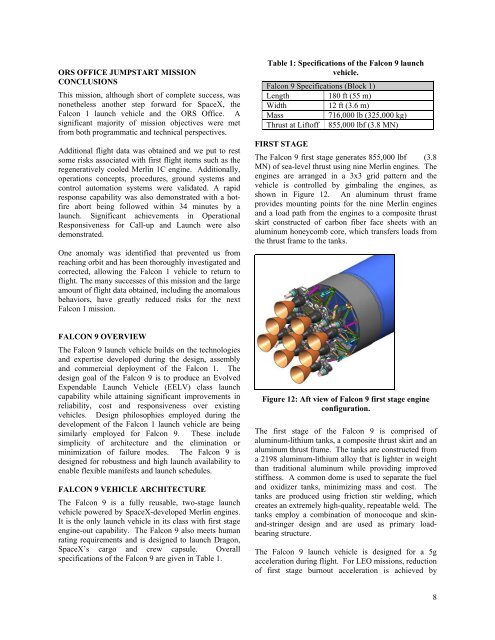The SpaceX Falcon 1 Launch Vehicle Flight 3 - International ...
The SpaceX Falcon 1 Launch Vehicle Flight 3 - International ...
The SpaceX Falcon 1 Launch Vehicle Flight 3 - International ...
You also want an ePaper? Increase the reach of your titles
YUMPU automatically turns print PDFs into web optimized ePapers that Google loves.
ORS OFFICE JUMPSTART MISSION<br />
CONCLUSIONS<br />
This mission, although short of complete success, was<br />
nonetheless another step forward for <strong>SpaceX</strong>, the<br />
<strong>Falcon</strong> 1 launch vehicle and the ORS Office. A<br />
significant majority of mission objectives were met<br />
from both programmatic and technical perspectives.<br />
Additional flight data was obtained and we put to rest<br />
some risks associated with first flight items such as the<br />
regeneratively cooled Merlin 1C engine. Additionally,<br />
operations concepts, procedures, ground systems and<br />
control automation systems were validated. A rapid<br />
response capability was also demonstrated with a hotfire<br />
abort being followed within 34 minutes by a<br />
launch. Significant achievements in Operational<br />
Responsiveness for Call-up and <strong>Launch</strong> were also<br />
demonstrated.<br />
One anomaly was identified that prevented us from<br />
reaching orbit and has been thoroughly investigated and<br />
corrected, allowing the <strong>Falcon</strong> 1 vehicle to return to<br />
flight. <strong>The</strong> many successes of this mission and the large<br />
amount of flight data obtained, including the anomalous<br />
behaviors, have greatly reduced risks for the next<br />
<strong>Falcon</strong> 1 mission.<br />
FALCON 9 OVERVIEW<br />
<strong>The</strong> <strong>Falcon</strong> 9 launch vehicle builds on the technologies<br />
and expertise developed during the design, assembly<br />
and commercial deployment of the <strong>Falcon</strong> 1. <strong>The</strong><br />
design goal of the <strong>Falcon</strong> 9 is to produce an Evolved<br />
Expendable <strong>Launch</strong> <strong>Vehicle</strong> (EELV) class launch<br />
capability while attaining significant improvements in<br />
reliability, cost and responsiveness over existing<br />
vehicles. Design philosophies employed during the<br />
development of the <strong>Falcon</strong> 1 launch vehicle are being<br />
similarly employed for <strong>Falcon</strong> 9. <strong>The</strong>se include<br />
simplicity of architecture and the elimination or<br />
minimization of failure modes. <strong>The</strong> <strong>Falcon</strong> 9 is<br />
designed for robustness and high launch availability to<br />
enable flexible manifests and launch schedules.<br />
FALCON 9 VEHICLE ARCHITECTURE<br />
<strong>The</strong> <strong>Falcon</strong> 9 is a fully reusable, two-stage launch<br />
vehicle powered by <strong>SpaceX</strong>-developed Merlin engines.<br />
It is the only launch vehicle in its class with first stage<br />
engine-out capability. <strong>The</strong> <strong>Falcon</strong> 9 also meets human<br />
rating requirements and is designed to launch Dragon,<br />
<strong>SpaceX</strong>’s cargo and crew capsule. Overall<br />
specifications of the <strong>Falcon</strong> 9 are given in Table 1.<br />
Table 1: Specifications of the <strong>Falcon</strong> 9 launch<br />
vehicle.<br />
<strong>Falcon</strong> 9 Specifications (Block 1)<br />
Length 180 ft (55 m)<br />
Width 12 ft (3.6 m)<br />
Mass 716,000 lb (325,000 kg)<br />
Thrust at Liftoff 855,000 lbf (3.8 MN)<br />
FIRST STAGE<br />
<strong>The</strong> <strong>Falcon</strong> 9 first stage generates 855,000 lbf (3.8<br />
MN) of sea-level thrust using nine Merlin engines. <strong>The</strong><br />
engines are arranged in a 3x3 grid pattern and the<br />
vehicle is controlled by gimbaling the engines, as<br />
shown in Figure 12. An aluminum thrust frame<br />
provides mounting points for the nine Merlin engines<br />
and a load path from the engines to a composite thrust<br />
skirt constructed of carbon fiber face sheets with an<br />
aluminum honeycomb core, which transfers loads from<br />
the thrust frame to the tanks.<br />
Figure 12: Aft view of <strong>Falcon</strong> 9 first stage engine<br />
configuration.<br />
<strong>The</strong> first stage of the <strong>Falcon</strong> 9 is comprised of<br />
aluminum-lithium tanks, a composite thrust skirt and an<br />
aluminum thrust frame. <strong>The</strong> tanks are constructed from<br />
a 2198 aluminum-lithium alloy that is lighter in weight<br />
than traditional aluminum while providing improved<br />
stiffness. A common dome is used to separate the fuel<br />
and oxidizer tanks, minimizing mass and cost. <strong>The</strong><br />
tanks are produced using friction stir welding, which<br />
creates an extremely high-quality, repeatable weld. <strong>The</strong><br />
tanks employ a combination of monocoque and skinand-stringer<br />
design and are used as primary loadbearing<br />
structure.<br />
<strong>The</strong> <strong>Falcon</strong> 9 launch vehicle is designed for a 5g<br />
acceleration during flight. For LEO missions, reduction<br />
of first stage burnout acceleration is achieved by<br />
8


